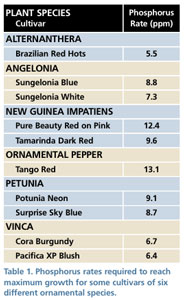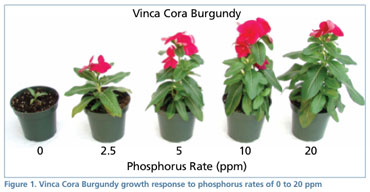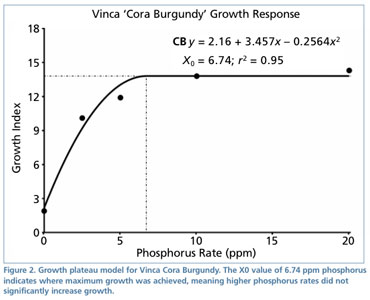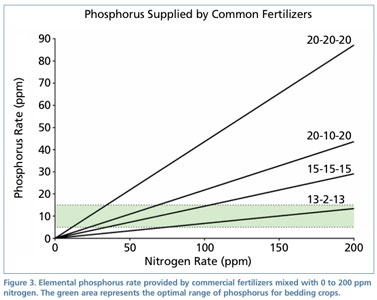5/31/2017
Go High or Go Low?
Josh Henry & Brian Whipker
Phosphorus (P) is one of the three primary macroelements essential for plant growth. Physiologically, P is a crucial component of cellular membranes and high energy molecules, such as ATP. These biological functions make P an important aspect of plant growth and development.
In greenhouse production, the P supply is dictated by your fertilization regiment, and thus, you as a grower are responsible for supplying your crop with the correct level. If P rates are too low, you can easily encounter symptoms of P deficiency. On the other hand, if you go too high, you’ll be battling excessive stretch. This begs the question: What P rate should you use to keep your plants healthy yet compact?
Research from North Carolina State University has sought to answer this question and determine how much P is needed in greenhouse production of ornamentals. Past research found that traditional P fertilization practices apply excessive levels of P, but didn’t make recommendations based on the common substrates and growing practices used in floriculture production.

Greenhouse crops are typically grown in soilless substrates, which have a low P-holding capacity. This means that P quickly leaches out of the pot if it’s not supplied constantly in the fertilizer regiment. Commercial fertilizers supply P in the form of phosphate (P2O5), which is denoted by the middle number in traditional fertilizer formulations. For instance, the “10” in 20-10-20 represents P2O5. To determine the P rate from P2O5, you simply must multiply the rate of P2O5 by 43%, as P2O5 consists of 43% P by mass. In this research, results are discussed in terms of elemental P, not P2O5.
How much P do you need?
A series of experiments were conducted in 2015/2016 to investigate the effects of increasing P rates on the overall growth and development of several floriculture crops. In the first experiments, alternanthera (Alternanthera brasiliana) and petunia (Petunia atkinsiana) plants were grown using P rates ranging from 0 to 80 ppm at every irrigation to determine upper and lower bounds of plant growth response to P.
In these experiments, the P rate varied while holding all other nutrients constant. For instance, nitrogen (N) and potassium (K) were held at 150 ppm each. These experiments indicated that growth differences only occur within a narrow range of P rates between 0 and 10 ppm P. Beyond 10 ppm P, no significant increases in growth were observed.
Since growth differences were only observed within this range, future experiments only used P rates between 0 and 20 ppm. New Guinea impatiens (Impatiens hawkeri), vinca (Catharanthus roseus), ornamental peppers (Capsicum annuum) and angelonia (Angelonia angustifolia) were grown with 0, 2.5, 5, 10 and 20 ppm P applied at every irrigation. Plant height, diameter and dry weight were measured and used to determine a growth index (GI). This GI provided each species with an accurate representation of overall growth.

Differences in growth were quite apparent within this range of P rates and can be observed with Vinca Cora Burgundy (Figure 1). The data for GI was used to determine a growth plateau model (Figure 2), which illustrates the overall trend in growth. Using this plateau model, we could determine the point at which growth “plateaued” past which point no significant increases in growth were observed. For Cora Burgundy, this point occurred at 6.74 ppm P (~16 ppm P2O5). This demonstrates that only a low rate of P was required to maximize growth for this cultivar.
Growth plateau models were created for each species and cultivar grown in these experiments. These plateaus were used to determine the P rate required by each cultivar to maximize growth. These experiments all indicated that current P fertilization regiments are much higher than necessary and that most greenhouse bedding plants only require a continual supply of 5 to 13 ppm P (12 to 30 ppm P2O5) to maximize growth (Table 1).

Alternanthera needed the lowest P rate, which may have been partially due to the fact that it was the only species we grew that didn’t produce flowers. On the other hand, New Guinea impatiens and ornamental peppers required slightly higher P rates, which may have been due to the high numbers of flowers and fruit produced by these species. Reproductive tissues are a great sink of nutrients and require higher levels of P than leaves and other tissues. This indicates that growers may wish to increase their P fertility slightly when growing plants that are in flower or setting fruit.
The primary goal of these experiments was to determine what levels of P maximized growth for several species and to use that data to improve fertilizer recommendations. There are many options available for growers who wish to utilize a low P fertilization strategy using commercial fertilizers. Figure 3 demonstrates how much P is supplied by common fertilizer formulations when mixed at increasing rates of N. Even when mixed at a low rate of N, high P fertilizers, such as 20-20-20 or 20-10-20, supply far more P than necessary.

For instance, 20-20-20 mixed at just 50 ppm N still supplies far more P than required by most floriculture crops. In fact, this would supply roughly four to five times the amount of P required for plants like alternanthera, which only needed 5.5 ppm P in our study. Low P fertilizers such as 13-2-13 provide optimal P rates when mixed at 75 to 200 ppm N. Growers may also wish to alternate between a fertilizer without P, such as 15-0-15, with a higher P formulation to achieve an average of 5 to 15 ppm P.
By lowering P fertility, growers can benefit from limited plant stretch and reduced P runoff. This fertilization strategy can enable you to use sustainable growing practices while continuing to produce top-quality plant material.
GT
Josh Henry is a PhD student and Brian Whipker is Professor of Floriculture at North Carolina State University.